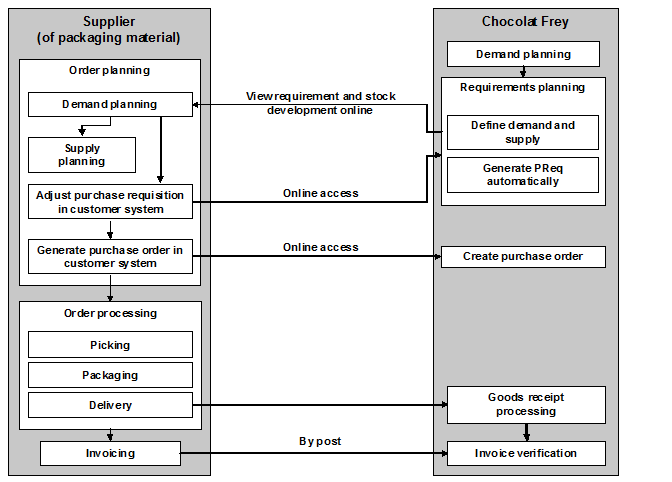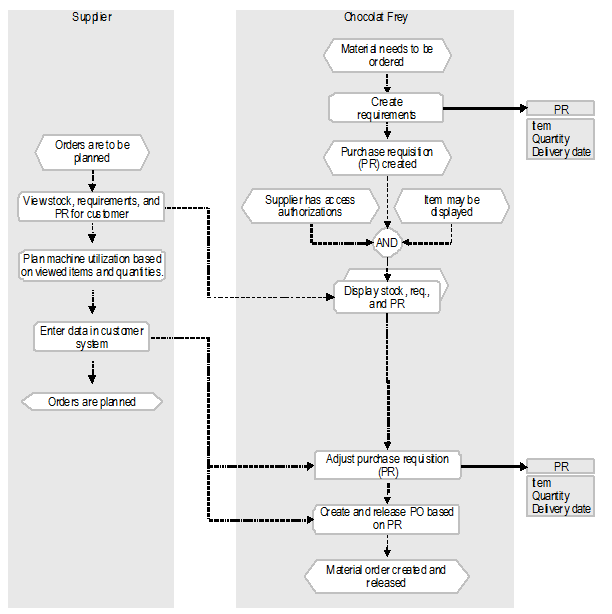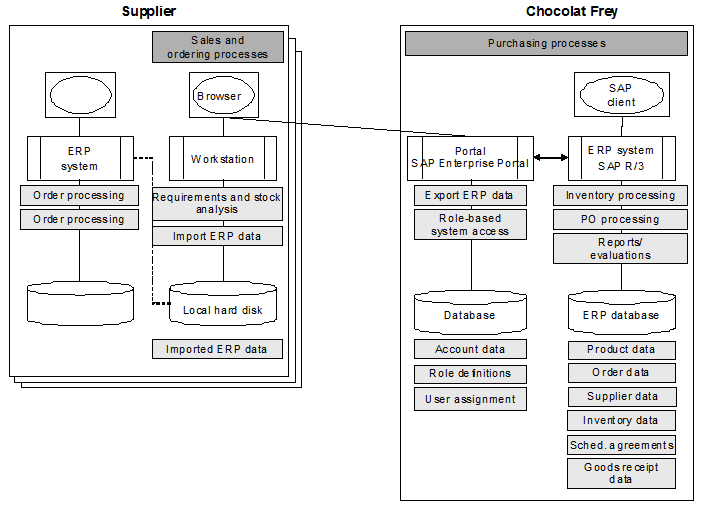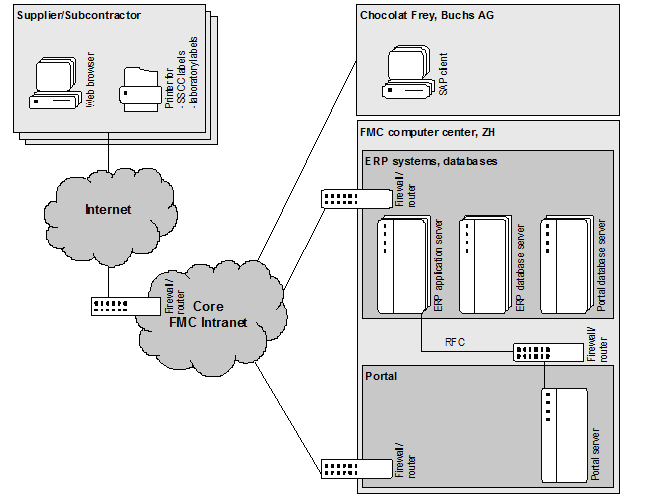Chocolat Frey AG: Vendor-Managed Inventory with SAP
Chocolat Frey AG, a member of the Federation of Migros Cooperatives, manufactures chocolate and chewing gum for the Swiss domestic market and the export market. To allow it to focus more strongly on its core competencies, Chocolat Frey introduced a vendor-managed inventory solution. The solution enables suppliers to monitor Chocolat Frey stocks and requirements around the clock and place orders when necessary. This case study describes the solution based on SAP NetWeaver and outlines its benefits for both Chocolat Frey and its suppliers.
Table of Contents
1. The Company2. What Triggered the Project
3. Vendor Managed Inventory mit SAP
Business Perspective , VMI , Process Perspective , Application Perspective , Portal, Technical Perspective , Security
4. Project Flow and Operation
Project Management, Development
5. Experiences
6. Success Factors
E-Collaboration
1. The Company
Background, Industry, Product, and Target Group
Chocolat Frey AG was founded by the Frey brothers in Aarau in 1887. In 1950, the company was taken over by Migros and integrated into the existing confectionery and sweet production business. In 1967, production moved from Aarau to new production facilities in Buchs and was amalgamated with the existing Migros Jowa chocolate factory. Chocolat Frey is fully owned by the Federation of Migros Cooperatives (FMC) and is based in Buchs in the Swiss Canton of Aargau.
Chocolat Frey manufactures chocolate and chewing gum. Chocolate production ranges from small slabs and bars, to specialty and seasonal products, as well as industrial finished products such as cocoa powder, chocolate for biscuits, ice cream, and so on. The assortment includes over 1,600 products. With a market share of 38% (according to Chocosuisse), Chocolat Frey has established itself as number 1 on the Swiss chocolate market. In 2006, the company sold around 43,500 tons of their products, which equates to a daily production of approx. 110 tons. With its 895 employees, the company achieved gross sales of CHF 400 million in 2006. Since 1982, the company has also been exporting to foreign countries.
Chocolate sales in Switzerland have plateaued at a very high level. The average annual consumption of chocolate is 11.6 kg per person. In addition to the competition from Lindt & SprĂĽngli and Cailler, Chocolat Frey is now also competing with market brand names, such as Ferrero, on sale at Migros sales points. To meet this increased competition, the company is now focusing on the export market. Until a few years ago, around 90-95% of the goods manufactured went to Migros. But now, exports constitute one third of total sales. In a few years from now, exports and products supplied to Migros are expected to be equally balanced.
In addition to the “Frey” branded products, export products are manufactured for specific customers and individually packaged with a private label. These are purchased by retail chains and intermediate customers.
Corporate Vision
In light of growing competition and increasing pricing pressure, the company continues to believe in quality and a good price-quality ratio. It intends to leverage its strengths on the export market to a greater degree and further extend the areas of brands and private labels.
Importance of IT and E-Business
Chocolat Frey primarily uses IT to support its processes. Due to the importance of efficient logistics processes, special focus is placed on these. The solution presented in this case study demonstrates how the company is using IT to boost efficiency and productivity.
2. What Triggered the Project
Initial Situation and Trigger for the Project
Some years ago, Chocolat Frey implemented a vendor-managed inventory solution (VMI) with a supplier. The supplier was able to use this solution to access certain data in the ERP system at Chocolat Frey and check the stock levels of its products to determine whether additional stocks needed to be delivered. However, when SAP R/3 was implemented as the group-wide ERP system in Migros companies at the start of 2001, this was no longer possible because the access rights could not be tweaked accordingly. While suppliers were eager for data access to be supported in a similar way to the old system, Chocolat Frey wanted to focus its attention on its core competencies. Both of these objectives could be met by a VMI solution – hence Chocolat Frey requested development of the solution outlined here.
Business Partners
Business Software Provider and Implementation Partner
The implementation partner and provider of the solution outlined in this case study is SAP (Schweiz) AG, an international subsidiary of SAP AG, which was founded in Walldorf, Germany in 1972. As market leader of ERP systems, SAP has more than 40,000 employees around the globe and over 39,000 customers. The company provides end-to-end software solutions to support business processes.
Business Partners
When the project originally began, it involved just one supplier, but other suppliers soon became involved too. These are primarily suppliers who produce packaging materials for Chocolat Frey products, as well as subcontractors. They prepackage individual products, such as chocolate bars for multipack sales promotions.
Another partner is Mibelle AG, which manufactures cosmetic and hygiene products. Mibelle AG is also owned by the Federation of Migros Cooperatives and commissioned the solution outlined here together with Chocolat Frey.
3. Vendor Managed Inventory mit SAP
Business Perspective and Goals
As previously mentioned in "Initial Situation and Trigger for the Project", the goal was to implement a vendor-managed inventory solution (VMI). With VMI, the supplier must ensure that an optimum quantity of material is available in its customer's warehouse at any given time. To do this, the supplier accesses predefined areas of the customer's ERP system. Advantages of VMI include reduced inventory throughout the supply chain, lower transaction costs, a closer and more reliable customer-supplier relationship, and a reduced level of warehouse stock at the customer. The idea was to allow suppliers to independently access and monitor stocks and requirements around the clock for those items they deliver, and to change and initiate orders (Fig. 1). The aim was to:
• Allow Chocolat Frey to focus its attention on its core competencies
• Give suppliers more independence in order handling
Due to seasonal fluctuations and sales promotions, demand for materials can fluctuate widely. Demand planning is therefore carried out continuously, and not just once a year.
There are currently two different portal roles at Chocolat Frey – the supplier and subcontractor roles. The supplier uses VMI to monitor stock development, process purchase requisitions and purchase orders, and create a scheduling agreement in terms of quantity and deadlines. The subcontractor can use the portal for the purposes of stock development, goods receipt, subsequently allocating orders, and transferring stock to various storage bins.
New producers for Chocolat Frey are not given access to the portal until they have worked together for some time and established mutual trust.
Chocolat Frey has a supply agreement with all suppliers that regulates the details of their cooperation. There is a supplementary agreement for suppliers who use the portal, which regulates how the system is to be operated, warehouse stock covered, and data confidentiality observed.

Fig. 1: Business Scenario for Vendor-Managed Inventory with Suppliers
Process Perspective
The ordering process is used here as a sample process to demonstrate how the portal and VMI are used. The process will be considered from two perspectives: from that of Chocolat Frey and of a supplier of packaging materials (Fig. 2).
The materials planner at Chocolat Frey carries out demand planning in the ERP system. If materials need to be ordered, the system automatically generates a purchase requisition based on stocks and requirements. The suppliers regularly check stocks, requirements, and purchase requisitions for Chocolat Frey and in doing so can only display the data relevant for their company. Requirements data is available on a day-to-day basis. The supplier uses this data to carry our demand planning. The purchase requisition generated is simply a system proposal; suppliers can adjust it to reflect their requirements. For example, suppliers can increase the quantity in the purchase requisition without consulting with Chocolat Frey if this allows them to better utilize machine capacity. Within the defined period in which the order is to be processed, suppliers can decide individually when and in how many units they want to process the order. The supplier adjusts the purchase requisition in the ERP system at Chocolat Frey to reflect planning arrangements and uses the data to generate a valid purchase order. The supplier also generates a purchase order on behalf of Chocolat Frey. The data and stocks in the system are adjusted and updated regularly, which means they are always up to date. The supplier then picks the goods and delivers them to Chocolat Frey.
Some orders require prior consultation between both parties before they can be processed, for example, orders involving a new design or product relaunch. Suppliers cannot use the portal to process orders of this kind. A materials planner at Chocolat Frey filters out these orders in the ERP system, so that they are not visible to the supplier. The planner then contacts the supplier directly before releasing the orders.

Fig. 2: Order Planning Process Perspective
Application Perspective
The core of the application is an SAP ERP system. It is used to process stocks and purchase orders, and generate reports and analyses (Fig. 3). The materials planner at Chocolat Frey logs on to the SAP ERP system directly via the SAP ERP client, without having to access the portal.
The portal is based on SAP Enterprise Portal, a component of SAP NetWeaver 2004. It is used to authenticate users and individually define access rights for functions and data in the ERP system. It is also used to display content and provide guidance to users. The portal has its own database, which stores account data, role definitions, and user assignments. Additional user information and all other data is stored in the central ERP system.

Fig. 3: Overview of Applications at Chocolat Frey
The supplier accesses Chocolat Frey's portal server by means of a Web browser. The advantage of using a Web browser is that no additional programs need to be installed or maintained and any Internet-enabled computer can be used. This allows new suppliers to use the portal functions quickly and easily.
After logging on, the user works directly in the Chocolat Frey ERP system (via the portal server), and changes to data are saved directly in the ERP system. No data is stored in the supplier’s system, which means suppliers must store this separately if required, or export the data from the Chocolat Frey ERP system and into their own system.
The portal comprises iViews, which are small programs installed on the portal server that process the user input from the Web browser and display data. iViews allow the portal to be adjusted easily to the needs of various users. If a user has to process goods receipts, for example, the relevant iView for this purpose is simply released. New customers can initially be given access to the most important functions, and additional functions can be granted at a later stage. Communication between the iViews and the ERP system is based on RFCs (Remote Function Calls). The portal server calls a function in the ERP system and forwards the response received to the browser.
Technical Perspective
The Federation of Migros Cooperatives computer center is responsible for running servers and services used by various FMC companies. This includes the ERP, portal, and database servers used by Chocolat Frey (Fig. 4). The advantage of this division of work within the FMC corporate group is that Chocolat Frey does not have to worry about maintenance and servicing. The various companies and the computer center are linked to one another via the Migros intranet (“Core”) [Security]. To prevent unauthorized access, they are connected to the intranet via a firewall. The portal server has its own intranet connection and is connected to the ERP system via an additional firewall for security reasons. The SAP clients at Chocolat Frey access the ERP systems using the Core network. Suppliers require access to the Internet, and access to the Migros intranet is also protected by a firewall. All connections are encrypted, which means "HTTPS" (Hypertext Transfer Protocol Secure) is used. If required, the supplier or subcontractor uses a printer to print SSCC or laboratory labels. The direct connection between the portal server and ERP system ensures that inquiries and results between the portal and ERP system are transmitted as quickly as possible and displayed in the portal.
Seven Migros companies are currently connected to the portal, and a total of twelve Chocolat Frey suppliers use its functions.

Fig. 4: Distribution of Technical Systems Used by Chocolat Frey
4. Project Flow and Operation
Investment Decision
The investment decision was based on a cost-benefit analysis, which assessed the efficiency and savings benefits for Chocolat Frey. It showed that the benefits for Chocolat Frey would outweigh the costs – by enabling Chocolat Frey to focus on its core competencies and allocate responsibilities to its suppliers, and by affording suppliers greater independence and allowing them to utilize machine capacity more effectively. It was predicted that the costs would be amortized over a short period.
Project and Change Management
Chocolat Frey began to plan its portal in August 2002. One of the key objectives was to implement a portal that could not only be used by Chocolat Frey, but also by other Migros industrial companies. However, the other companies did not initially recognize the benefits of the portal, were skeptical about security, and had little interest in participating in the project. For this reason, Chocolat Frey planned the portal in line with its own requirements. Two months later, another Migros company, Mibelle, joined the project. The project was then stopped and new research was carried out with the aim of implementing a portal that could also be used by other companies after all.
Six months later, the solution was in place. Chocolat Frey used the time between when the SAP system was implemented at the start of 2001 and when the portal was planned to gain experience with the ERP system and determine what data suppliers should be granted access.
Partner Selection
SAP (Schweiz) AG implemented a corporate ERP system for the Migros companies in 2001. This allowed Chocolat Frey to gain valuable experience with SAP. Selecting SAP as the VMI solution partner enabled them to avoid interface problems, since both the ERP system and the portal are supplied by the same provider. Obtaining the complete solution from one source also allows for better support. A further advantage lay in the fact that the SAP license fees covered all SAP modules, including those that are not actually used. This meant that no license fees and only implementation costs would be incurred for the VMI solution.
Development and Rollout of the Software Solution
When developing the portal, SAP was able to draw on SAP NetWeaver 2004 Enterprise Portal and the reference processes implemented for it. The additional functions required by Chocolat Frey were implemented in a custom-developed enhancement to the standard SAP application. The Migros solution, for example, included new stock and purchase processing functions as well as an option to process purchase orders at a later stage.
The processes were modeled exactly as Chocolat Frey required. The user interface design selected was chosen to allow the interface to be tailored to the needs of individual users and their processes. Keeping the number of user roles to a minimum was a further aspect considered. Just two roles are used at Chocolat Frey: one for the supplier and one for the subcontractor.
Continuous Maintenance
The FMC computer center runs the portal server and the relevant ERP servers. This frees Chocolat Frey of the responsibility of ensuring that the servers run smoothly. Almost all data is maintained in the ERP system. This means that running the portal does not result in additional data maintenance effort. The only data to be defined in the portal is the data required for granting access rights. The FMC bears the costs incurred for operating and maintaining the solution. Overall costs for continuous maintenance are very low.
5. Experiences
User Acceptance
The portal implementation was initially met with much skepticism from suppliers. Many felt that Chocolat Frey wanted to offload work to them without offering them anything in return. But this view has since changed. Suppliers are now enthusiastic about the portal solution and do not want to do without it. Both Chocolat Frey and the Migros companies had serious reservations about security, since suppliers can trigger and adjust purchase orders themselves. But these concerns were soon allayed as it became apparent that supplier trust is well founded and is in the best interests of the Migros companies involved. Whenever they discover potential errors in the system data, for example if questionable quantities are ordered, they notify the customer.
Achievement of Goals and Changes Brought About
The requirements and goals defined for the solution were met in full. The solution afforded suppliers greater independence by allowing them to trigger purchase orders themselves and decide how to split deliveries based on the minimum and maximum quantities defined by Chocolat Frey. This enables them to adjust production to reflect customer demand and optimize machine and resource utilization.
Chocolat Frey’s aims to implement a portal solution that would allow it focus its attention on its core business and allocate some tasks to its suppliers were met in full. The solution has also improved delivery reliability. Chocolat Frey is always kept informed of suppliers’ activities and the data in the system is always up to date. Cost reductions were also achieved by optimizing warehouse management and eliminating personnel effort for requirements planning and procurement.
The relationship between Chocolat Frey and its suppliers that use the portal has also improved. Trust and independence are now stronger than ever before.
Investments, Profitability, and Key Figures
As pilot customers and co-developers of the solution, Chocolat Frey and Mibelle did not have to pay the full development costs. In return, SAP is entitled to offer the functions developed to other customers. The costs for the portal solution, excluding hardware, amounted to approximately CHF 320,000. A further CHF 58,000 was invested in hardware. This cost was initially shared by Chocolat Frey and Mibelle. However, the FMC later purchased the solution to make it available for all Migros companies. The SAP license for the ERP system includes the use of the portal solution, which means that additional license costs are not incurred. And since the system environments are operated and maintained centrally in the FMC, additional operational costs are only marginal. Compared to the previous setup, the solution generates savings of about two person days of work a week.
6. Success Factors
Special Features of the Solution
One special feature of the solution is the approach taken to plan and implement the portal to allow it to be used by many Migros companies. As anticipated by the project managers, other Migros companies adopted the solution soon after the portal went live. The advantage of the solution’s design and use of the portal to display the data from the ERP system is that suppliers do not have to access the ERP system itself. The solution's fully integrated, lean approach is also a big plus. Most data is maintained centrally in the ERP system and the portal settings can be configured to define exactly which data specific suppliers are permitted to view.
Reflection of “Business Collaboration”
Implementation of the portal solution has strengthened collaboration between Chocolat Frey and its suppliers. Chocolat Frey’s trust in its suppliers and the electronic collaboration that this enables allowed both parties to optimize their business processes.
A key feature of the solution is that Chocolat Frey allows its suppliers to work directly in the ERP system and access detailed information. Suppliers are even permitted to independently trigger purchase orders on behalf of Chocolat Frey. Suppliers reciprocate this trust by critically examining the data in the system and assuming responsibility for tasks previously carried out by Chocolat Frey. In return, they are granted access to up-to-date data and have the flexibility to decide when deliveries are made. This allows them to utilize machine and resource capacity more effectively and work more productively. They are also no longer bound by the working hours at Chocolat Frey. This collaboration model is thus a win-win situation for all involved.
Another major advantage of this model is the 'calmness' it has brought about. Since its implementation, there have been fewer supplier queries and the coordination required between the parties has almost been eliminated. Each partner can now use the time saved to focus on its competencies and make its processes more efficient.
Lessons Learned
The solution presented here shows how relatively modest effort and mutual trust can simplify collaboration between two or more business partners, enabling both parties to benefit.
The time between implementation of the ERP system and the portal was put to good use: The system was carefully examined during this time, allowing the parties involved to understand what it can and cannot do. It enabled Chocolat Frey to define what information to display to suppliers. This goes to show that it can be beneficial to become acquainted with a new system first before proceeding to enhance it with additional functions.



